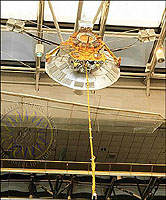Pioneer 10 was the first spacecraft to fly by Jupiter, the largest planet in the Solar System. It later became the first human-made object to cross the orbit of Pluto, the farthest planet. Pioneer 10 was launched on March 3, 1972. It entered the asteroid belt on July 15 and emerged unscathed seven months later. Pioneer 10 encountered Jupiter in early December 1973 and sent back the first close-up color pictures of the planet and data about its atmosphere, magnetic fields, and radiation belts. In June 1983, Pioneer 10 reached a distance beyond all the known planets. The spacecraft displayed here is a reconstructed full-scale replica. It was assembled by TRW in 1977 from space parts provided by JPL, TRW, and Teledyne Energy Systems (Radioisotope Thermoelectric Generators (RTG) casings). Some of those spare parts had been used for testing.
More Information: |
![]() 1976
Viking Lander | Milestones of Flight |
1987 Pershing II &
SS-20
1976
Viking Lander | Milestones of Flight |
1987 Pershing II &
SS-20 ![]()
©National Air and Space Museum
